
Chapter 12: Introduction to Genetics >
12.1 The Work of Gregor Mendel
*Skip to “Definitions and Explanation” if you want to get straight to the point;
skip to highlighted portions for review
Genetics is the study of biological inheritance. One of the most famous people involved with this study is Gregor Mendel, best known for his experiments with peas.
Flowers produce pollen (contain male reproductive cells: sperm), and also have a female portion with female reproductive cells (eggs). In fertilization, female and male reproductive cells join, making a new cell.
Pea flowers are typically self-pollinating, meaning their seeds can have characteristics solely inherited from one parent. Since Mendel wanted to experiment by crossing the characteristics of two plants, he utilized cross-pollination to cross the traits of two plants.

He prevented self-pollination by cutting off the male parts of a flower (pollen) and dusting the pollen from a different plant on the female part of that flower.
In Mendel's experiments, seven different traits were examined, each having contrasting characteristics (ex-green or yellow pod color). He crossed plants with the seven characteristics and then studied their offspring. Offspring produced when contrasting traits are crossed are called hybrids. But surprisingly, these hybrid plants had the characteristics of only one parent (observed in figure 12-2), leading him to conclude that characteristics are determined by genes.
Genes: sequence of DNA that codes for a protein and thus determines a trait; factor that is passed from parent to offspring
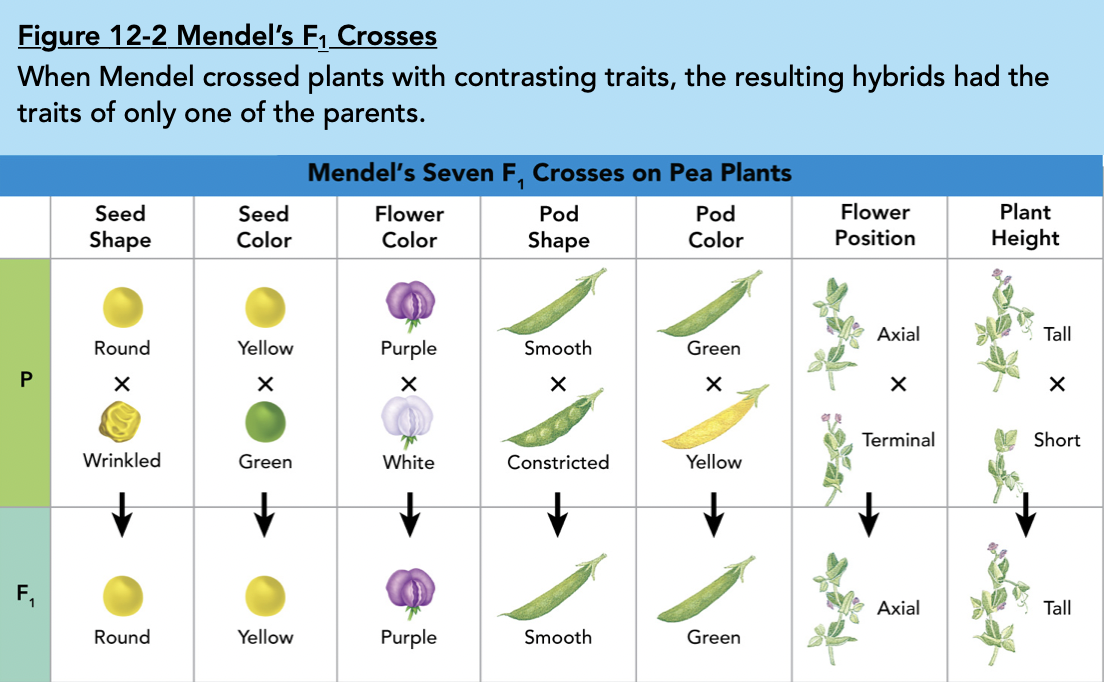
An example of a gene would be seed shape, and its different alleles (variations of a gene) would be round and wrinkled.
From Mendel’s observations, he determined that there was a dominant and recessive trait/allele. For example, tall height over short height. <Principle of Dominance
So did these recessive genes just disappear? To find out, Mendel allowed the F1 hybrids to self-pollinate and produce a F2 generation (second filial), and so that the recessive gene traits actually reappeared in 1/4 of the offspring. For this to happen, the alleles for green and yellow pods had to have separated(segregation), during the formation of the reproductive cells (gametes).
*Definitions and Explanation [on gamete separation]
Genetics: The study of inherited characteristics (heredity)
Fertilization: Male and female reproductive cells (gametes) join to make a new cell (zygote)
Trait: A specific characteristic of an animal (a characteristic could be flower color, while the trait would be purple flower color)
Hybrid: The offspring of parents with different traits
Gene: Factor passed from parents to offspring (Flower color)
Allele: A form of a gene (purple flower color)
Principle of Dominance: States that some alleles are dominant and others are recessive
Gamete: A reproductive cell (sperm and egg)
Segregation: the separation of allele pairs 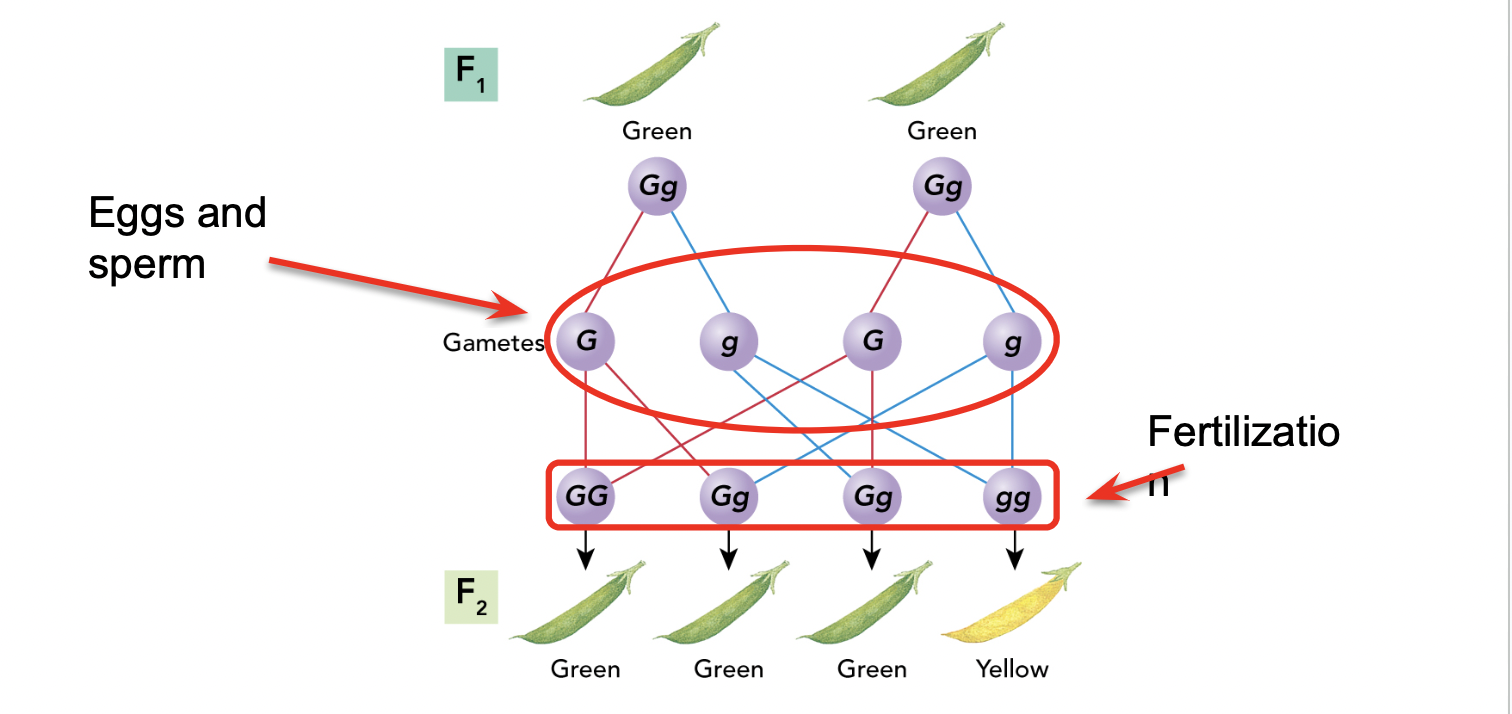
Alleles segregate during gamete formation
Each gamete receives one allele from each gene pair
The law of segregation states that the two alleles of a gene separate during gamete formation and end up in different gametes
This results in the production of genetically diverse gametes, which can combine during fertilization to produce offspring with unique genetic traits
12.2 Applying Mendel's Principles
Although we cannot be certain about many things in genetics, we can determine the likelihood of traits being passed down. By using probability, Mendel made predictions about the likelihood of a particular trait being expressed in offspring.
If you flip a coin, there are two possible outcomes: heads or tails. Therefore, the chances are 1/2 (50%). But if you flip the coin three times, the chances of it landing on one side every time is 1/8, because you multiply 1/2 by itself three times. 
Genotype vs. Phenotype
Genotype: The genetic makeup of an organism, including all of its genes and alleles.
Ex- AA, Aa, or aa
Determines the potential traits an organism can have.
Is inherited from parents.
Can be expressed or unexpressed.
Can be homozygous (AA, aa) or heterozygous (Aa).
Phenotype: The observable physical and behavioral traits of an organism
Ex- hair color, seed shape, fur color
Is the result of the expression of the genotype and the environment.
Can be influenced by environmental factors such as nutrition, temperature, and stress.
Can vary among individuals with the same genotype.
Punnet Squares
Punnett squares are diagrams commonly used to predict the genotypes and phenotypes of a genetic cross
Write the alleles for one parent across the top of the Punnett square, and the other parent down the left side of the Punnett square.
Fill in the boxes by combining the alleles from each parent.
Determine the genotype and phenotype ratios by counting the number of each possible outcome.
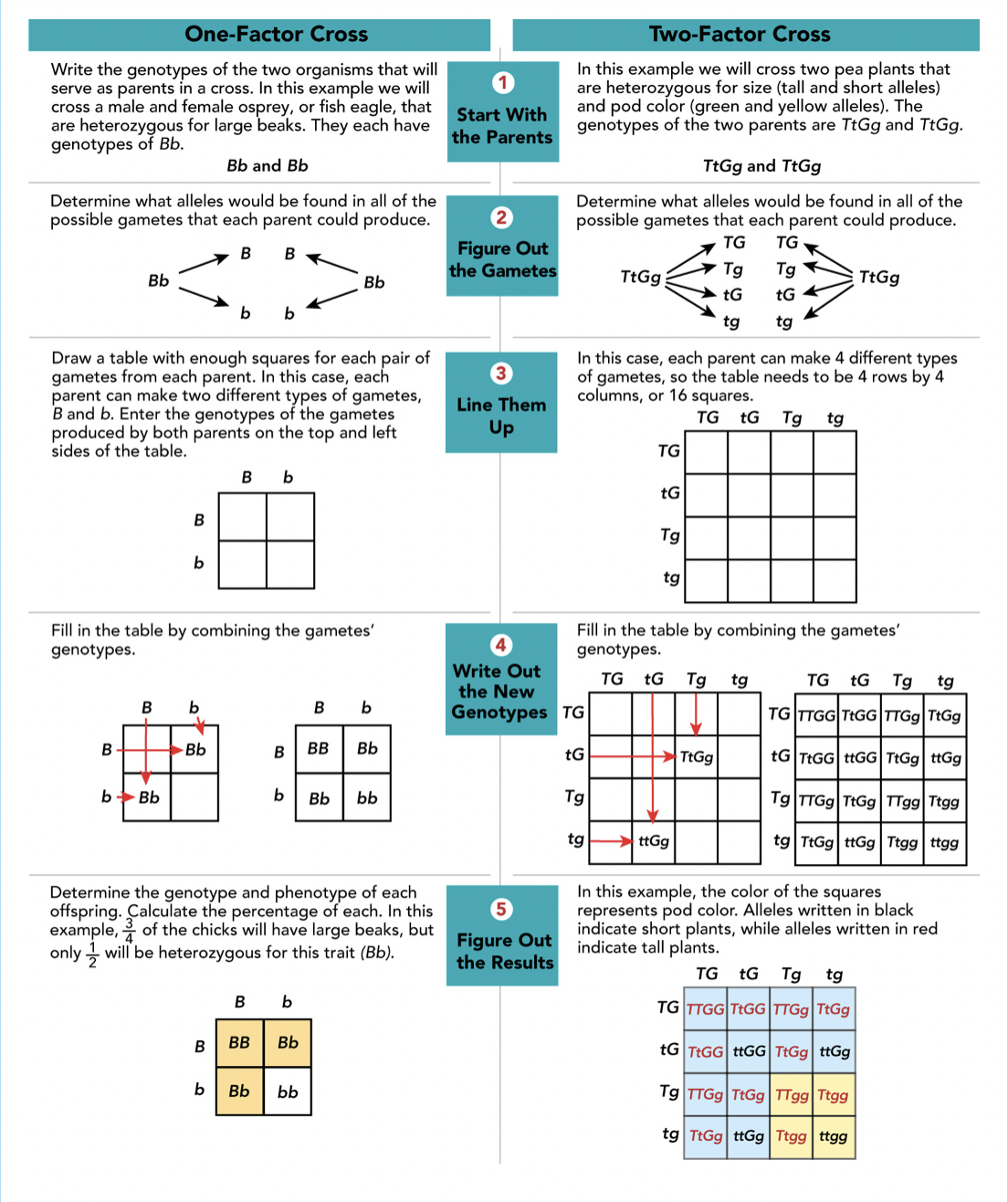
Independent Assortment
Independent assortment is a principle of genetics stating that the alleles of two or more different genes get sorted into gametes independently of one another. This means that the inheritance of one trait does not affect the inheritance of another trait.
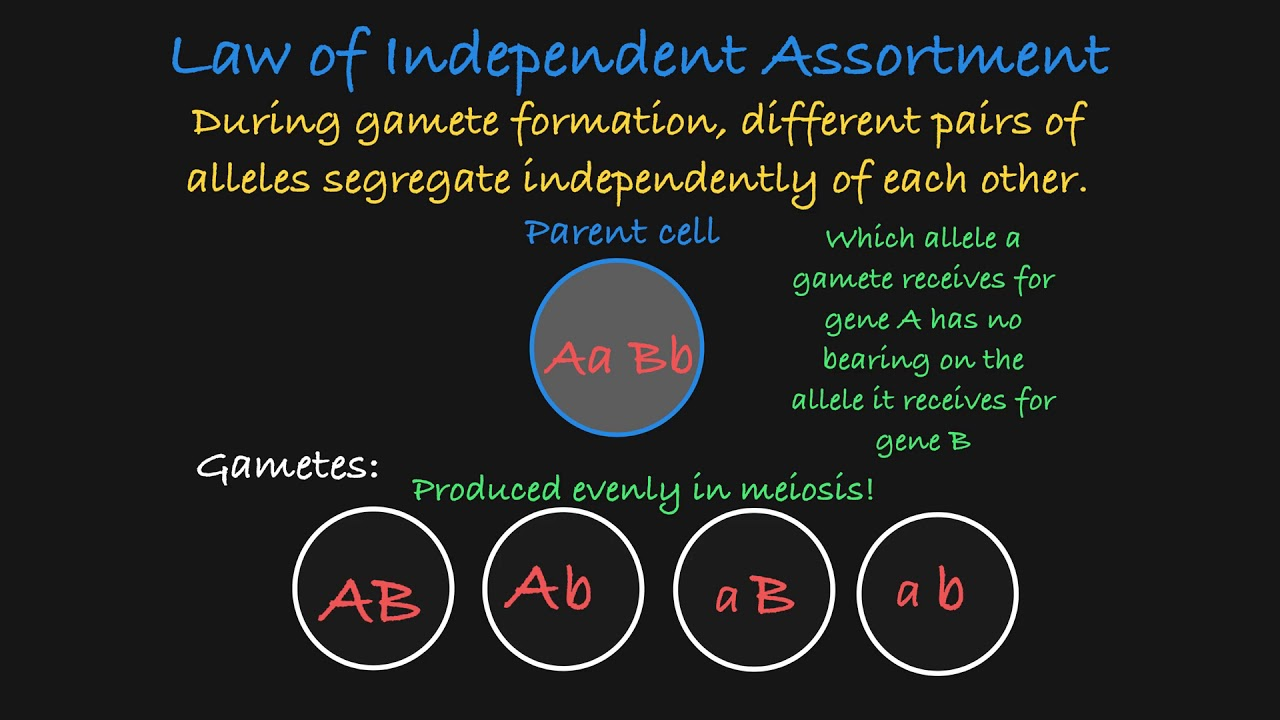
Summary of Mendel’s Laws
Law of Segregation: Each individual has two copies of each gene, and these copies segregate (separate) during gamete formation.
Law of Independent Assortment: Genes for different traits are inherited independently of each other.
Law of Dominance: In a heterozygous individual (having two different alleles for a gene), one allele will be expressed over the other.
Segregation vs Independent Assortment:
Segregation is the separation of alleles in one gene and can be observed in one-factor crosses(ex- Aa to A, a).
separation of one gene into gametes
On the other hand, Independent Assortment is the separation of alleles from different genes which form combinations, where the inheritance of one trait does not influence the inheritance of another trait (observed in dihybrid crosses).
separation of the alleles from different genes into gametes
12.3 Other Patterns of Inheritance
Most genes don't work as simply as dominant and recessive, some other patterns include:
Incomplete Dominance
Some alleles are neither dominant nor recessive
results in a phenotype in which the expressed physical trait is a combination of the parental traits

Co-dominance
The phenotypes for both alleles are clearly expressed
Examples; chicken feather color, blood type
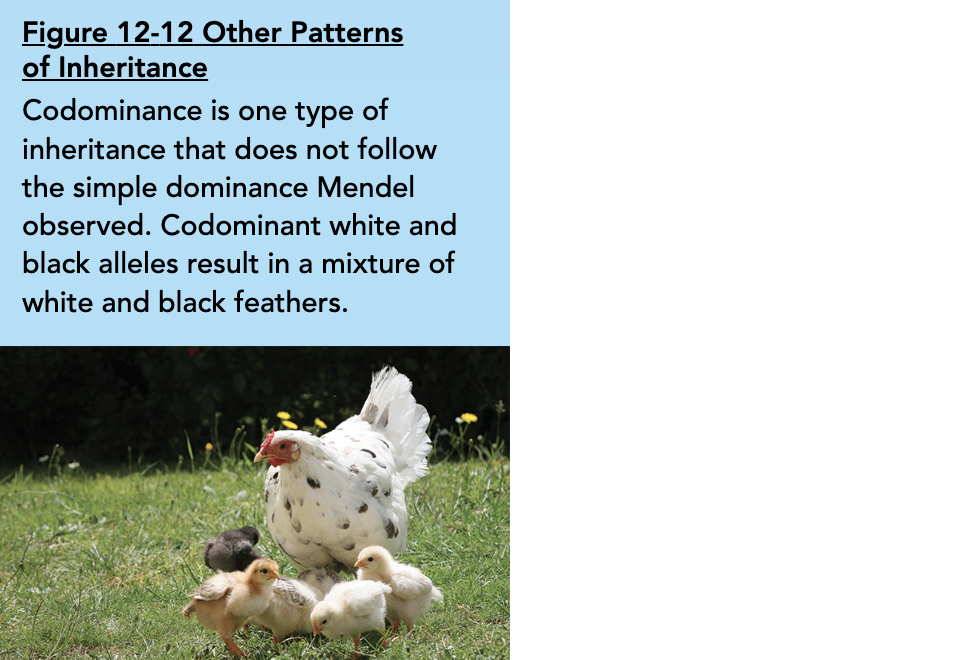
Multiple alleles
Many genes exist in more than two forms, and therefore have multiple alleles
Examples: Human blood types, fur color in rabbits 
Polygenic Traits
Many traits are produced by the interaction of several genes
Examples: eye colo
r in fruit flies, skin color, height
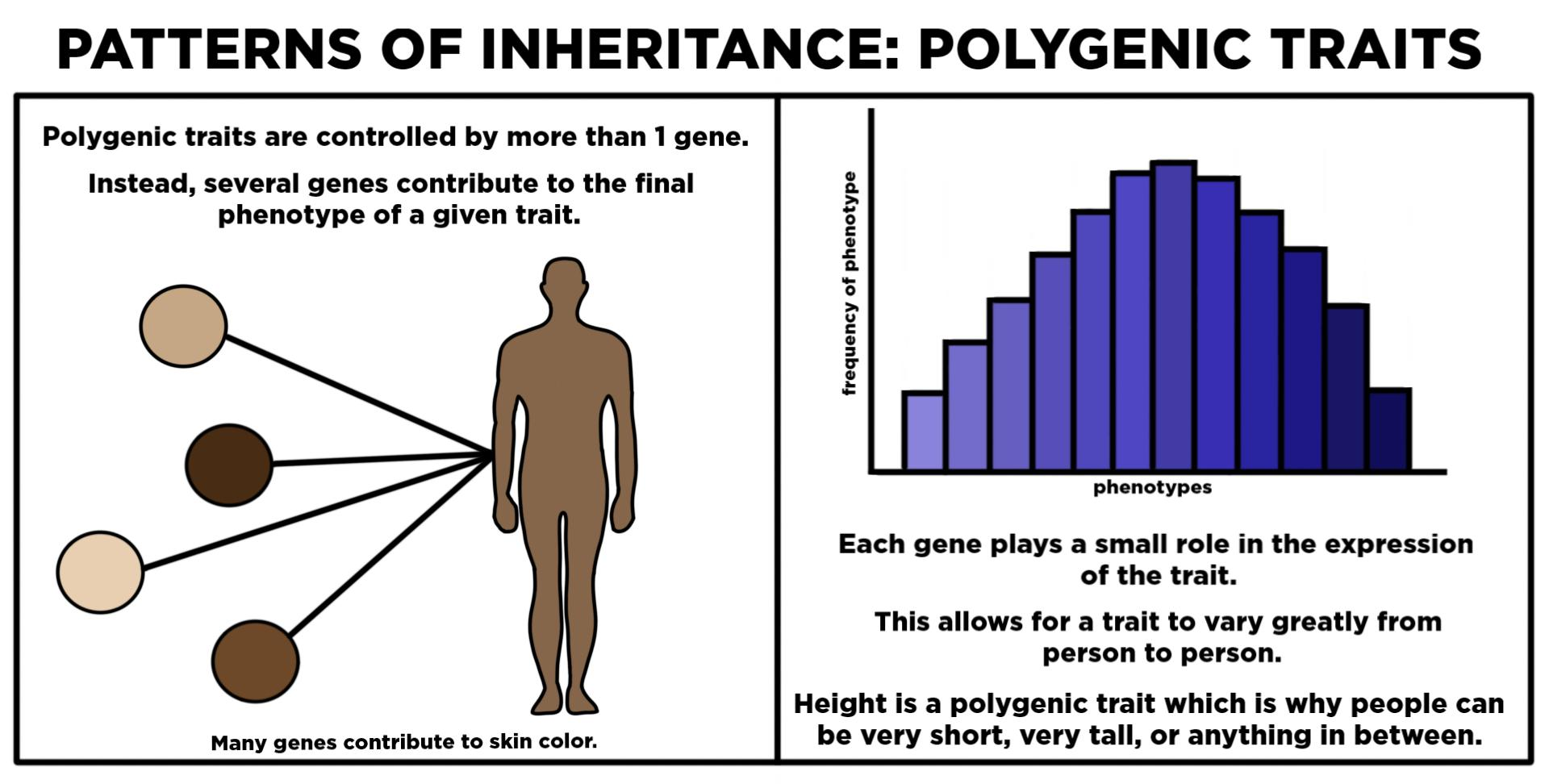
Note: Environmental conditions can affect gene expression and influence genetically determined traits. For example, some butterflies are darker in the autumn than they are in summer, showing how an environmental aspect (temperature) influences physical appearance
12.4 Meiosis
Meiosis occurs to ensure that offspring from two parents has the correct number of chromosomes.
More terms
Homologous:
chromosomes where one set comes from the male parent, while the other from the female parent
Crossing over:
homologous chromosomes exchange genetic material by exchanging portions of their chromatids (important for genetic variation)
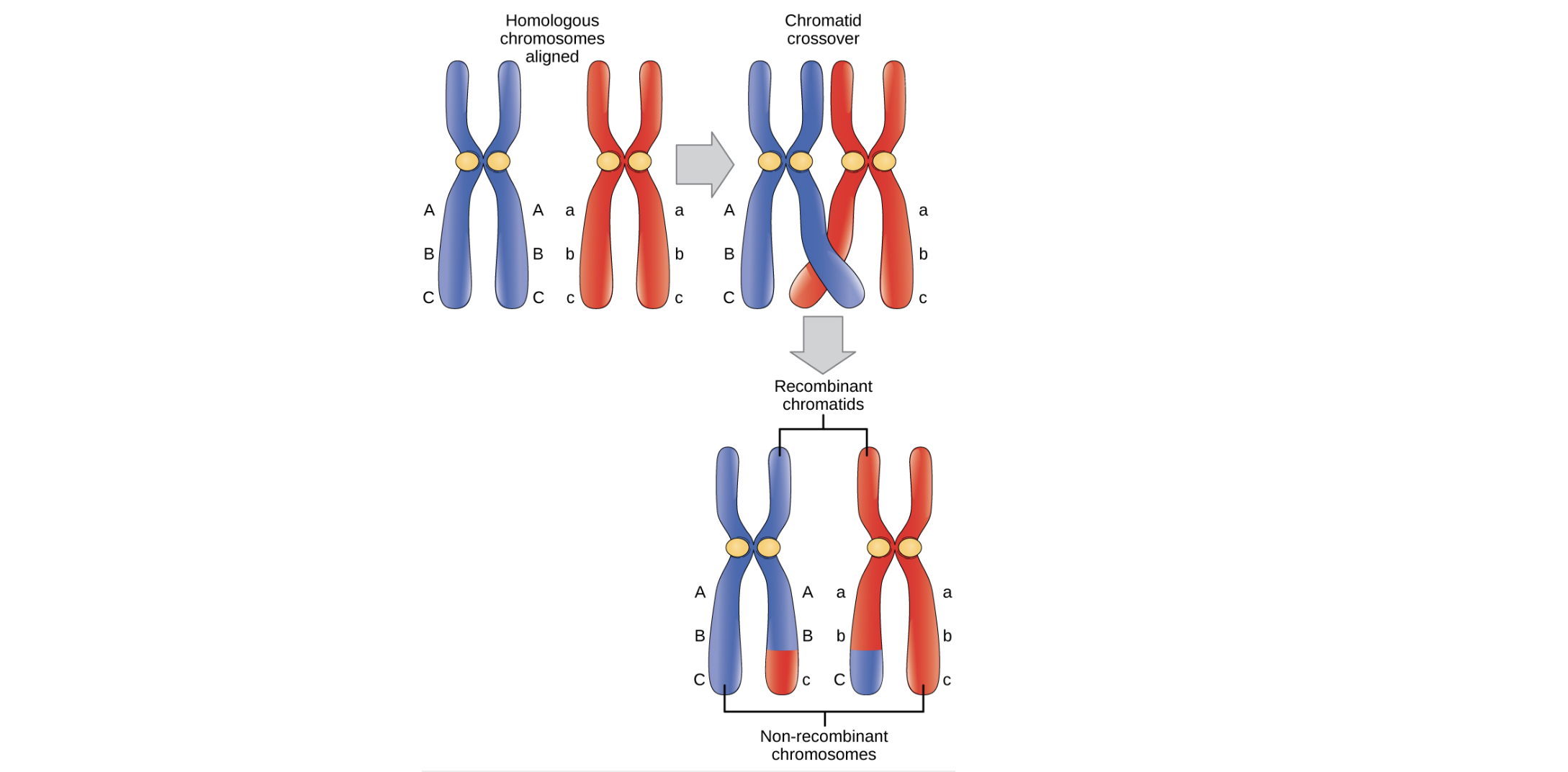
Diploid cells:
a cell with two sets of chromosomes or twice the haploid number
Haploid cells:
a cell with only a single set of unpaired chromosomes
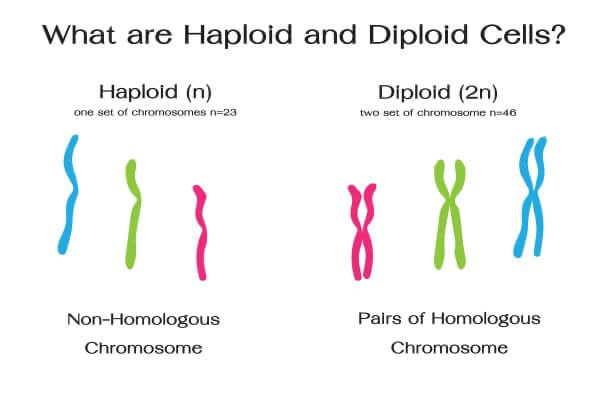
Tetrad:
structure containing four chromatids that forms during meiosis

Meiosis
Meiosis is a type of cell division that produces gametes (sex cells) with half the number of chromosomes as the parent cell. It involves two rounds of cell division, resulting in four genetically diverse daughter cells.
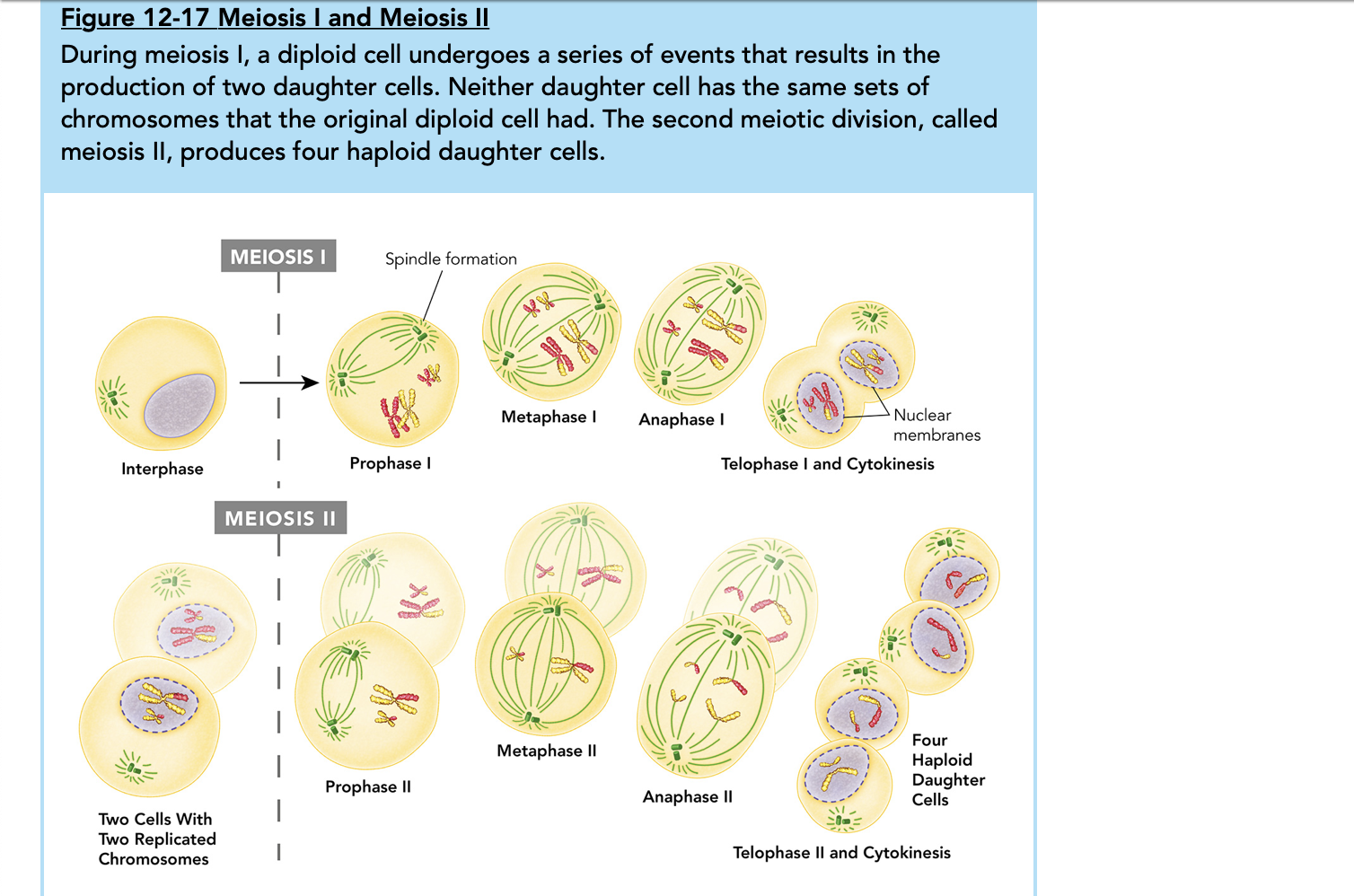
Prophase I
Chromosomes condense and become visible
Homologous chromosomes pair up and exchange genetic material through crossing over, forming a tetrad
Nuclear membrane breaks down
Metaphase I
Homologous chromosome pairs align at the equator of the cell
-Independent assortment occurs here because the homologous chromosome pairs are randomly paired together, allowing for many gamete possibilities
Spindle fibers attach to each chromosome
Anaphase I
Homologous chromosomes separate and move to opposite poles of the cell
Sister chromatids remain attached
Telophase I
Chromosomes reach opposite poles of the cell
Nuclear membrane reforms around each set of chromosomes
Cytokinesis occurs, resulting in two haploid daughter cells
Meiosis II (chromosome replication does not occur since there is no interphase)
Prophase II
Chromosomes condense again
-tetrads are not formed because homologous pairs are already separated
Nuclear membrane breaks down
Metaphase II
Chromosomes align at the equator of the cell
Spindle fibers attach to each sister chromatid
Anaphase II
Sister chromatids separate and move to opposite poles of the cell
Telophase II
Chromosomes reach opposite poles of the cell
Nuclear membrane reforms around each set of chromosomes
Cytokinesis occurs, resulting in four haploid daughter cells
results in four haploid daughter cells (gametes) with two chromosomes each
Mitosis vs. Meiosis Diagram
The Creation of Sperm and Egg cells, Gametogenesis
in female cells, meiosis is known as…
Oogenesis (ooh)

Making a mature egg
Cytoplasm divides unevenly
Makes one “good” egg and three polar bodies
The three polar bodies self digest with lysosomes (apoptosis)
in male cells, meiosis is known as…
Spermatogenesis
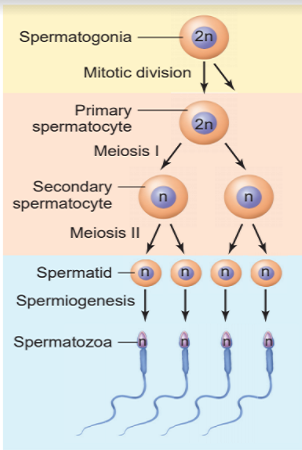
Achieved through mitosis and meiosis
Makes mature sperm
Chapter 12: Introduction to Genetics >
12.1 The Work of Gregor Mendel
*Skip to “Definitions and Explanation” if you want to get straight to the point;
skip to highlighted portions for review
Genetics is the study of biological inheritance. One of the most famous people involved with this study is Gregor Mendel, best known for his experiments with peas.
Flowers produce pollen (contain male reproductive cells: sperm), and also have a female portion with female reproductive cells (eggs). In fertilization, female and male reproductive cells join, making a new cell.
Pea flowers are typically self-pollinating, meaning their seeds can have characteristics solely inherited from one parent. Since Mendel wanted to experiment by crossing the characteristics of two plants, he utilized cross-pollination to cross the traits of two plants.

He prevented self-pollination by cutting off the male parts of a flower (pollen) and dusting the pollen from a different plant on the female part of that flower.
In Mendel's experiments, seven different traits were examined, each having contrasting characteristics (ex-green or yellow pod color). He crossed plants with the seven characteristics and then studied their offspring. Offspring produced when contrasting traits are crossed are called hybrids. But surprisingly, these hybrid plants had the characteristics of only one parent (observed in figure 12-2), leading him to conclude that characteristics are determined by genes.
Genes: sequence of DNA that codes for a protein and thus determines a trait; factor that is passed from parent to offspring

An example of a gene would be seed shape, and its different alleles (variations of a gene) would be round and wrinkled.
From Mendel’s observations, he determined that there was a dominant and recessive trait/allele. For example, tall height over short height. <Principle of Dominance
So did these recessive genes just disappear? To find out, Mendel allowed the F1 hybrids to self-pollinate and produce a F2 generation (second filial), and so that the recessive gene traits actually reappeared in 1/4 of the offspring. For this to happen, the alleles for green and yellow pods had to have separated(segregation), during the formation of the reproductive cells (gametes).
*Definitions and Explanation [on gamete separation]
Genetics: The study of inherited characteristics (heredity)
Fertilization: Male and female reproductive cells (gametes) join to make a new cell (zygote)
Trait: A specific characteristic of an animal (a characteristic could be flower color, while the trait would be purple flower color)
Hybrid: The offspring of parents with different traits
Gene: Factor passed from parents to offspring (Flower color)
Allele: A form of a gene (purple flower color)
Principle of Dominance: States that some alleles are dominant and others are recessive
Gamete: A reproductive cell (sperm and egg)
Segregation: the separation of allele pairs 
Alleles segregate during gamete formation
Each gamete receives one allele from each gene pair
The law of segregation states that the two alleles of a gene separate during gamete formation and end up in different gametes
This results in the production of genetically diverse gametes, which can combine during fertilization to produce offspring with unique genetic traits
12.2 Applying Mendel's Principles
Although we cannot be certain about many things in genetics, we can determine the likelihood of traits being passed down. By using probability, Mendel made predictions about the likelihood of a particular trait being expressed in offspring.
If you flip a coin, there are two possible outcomes: heads or tails. Therefore, the chances are 1/2 (50%). But if you flip the coin three times, the chances of it landing on one side every time is 1/8, because you multiply 1/2 by itself three times. 
Genotype vs. Phenotype
Genotype: The genetic makeup of an organism, including all of its genes and alleles.
Ex- AA, Aa, or aa
Determines the potential traits an organism can have.
Is inherited from parents.
Can be expressed or unexpressed.
Can be homozygous (AA, aa) or heterozygous (Aa).
Phenotype: The observable physical and behavioral traits of an organism
Ex- hair color, seed shape, fur color
Is the result of the expression of the genotype and the environment.
Can be influenced by environmental factors such as nutrition, temperature, and stress.
Can vary among individuals with the same genotype.
Punnet Squares
Punnett squares are diagrams commonly used to predict the genotypes and phenotypes of a genetic cross
Write the alleles for one parent across the top of the Punnett square, and the other parent down the left side of the Punnett square.
Fill in the boxes by combining the alleles from each parent.
Determine the genotype and phenotype ratios by counting the number of each possible outcome.

Independent Assortment
Independent assortment is a principle of genetics stating that the alleles of two or more different genes get sorted into gametes independently of one another. This means that the inheritance of one trait does not affect the inheritance of another trait.

Summary of Mendel’s Laws
Law of Segregation: Each individual has two copies of each gene, and these copies segregate (separate) during gamete formation.
Law of Independent Assortment: Genes for different traits are inherited independently of each other.
Law of Dominance: In a heterozygous individual (having two different alleles for a gene), one allele will be expressed over the other.
Segregation vs Independent Assortment:
Segregation is the separation of alleles in one gene and can be observed in one-factor crosses(ex- Aa to A, a).
separation of one gene into gametes
On the other hand, Independent Assortment is the separation of alleles from different genes which form combinations, where the inheritance of one trait does not influence the inheritance of another trait (observed in dihybrid crosses).
separation of the alleles from different genes into gametes
12.3 Other Patterns of Inheritance
Most genes don't work as simply as dominant and recessive, some other patterns include:
Incomplete Dominance
Some alleles are neither dominant nor recessive
results in a phenotype in which the expressed physical trait is a combination of the parental traits

Co-dominance
The phenotypes for both alleles are clearly expressed
Examples; chicken feather color, blood type

Multiple alleles
Many genes exist in more than two forms, and therefore have multiple alleles
Examples: Human blood types, fur color in rabbits 
Polygenic Traits
Many traits are produced by the interaction of several genes
Examples: eye colo
r in fruit flies, skin color, height

Note: Environmental conditions can affect gene expression and influence genetically determined traits. For example, some butterflies are darker in the autumn than they are in summer, showing how an environmental aspect (temperature) influences physical appearance
12.4 Meiosis
Meiosis occurs to ensure that offspring from two parents has the correct number of chromosomes.
More terms
Homologous:
chromosomes where one set comes from the male parent, while the other from the female parent
Crossing over:
homologous chromosomes exchange genetic material by exchanging portions of their chromatids (important for genetic variation)

Diploid cells:
a cell with two sets of chromosomes or twice the haploid number
Haploid cells:
a cell with only a single set of unpaired chromosomes

Tetrad:
structure containing four chromatids that forms during meiosis

Meiosis
Meiosis is a type of cell division that produces gametes (sex cells) with half the number of chromosomes as the parent cell. It involves two rounds of cell division, resulting in four genetically diverse daughter cells.

Prophase I
Chromosomes condense and become visible
Homologous chromosomes pair up and exchange genetic material through crossing over, forming a tetrad
Nuclear membrane breaks down
Metaphase I
Homologous chromosome pairs align at the equator of the cell
-Independent assortment occurs here because the homologous chromosome pairs are randomly paired together, allowing for many gamete possibilities
Spindle fibers attach to each chromosome
Anaphase I
Homologous chromosomes separate and move to opposite poles of the cell
Sister chromatids remain attached
Telophase I
Chromosomes reach opposite poles of the cell
Nuclear membrane reforms around each set of chromosomes
Cytokinesis occurs, resulting in two haploid daughter cells
Meiosis II (chromosome replication does not occur since there is no interphase)
Prophase II
Chromosomes condense again
-tetrads are not formed because homologous pairs are already separated
Nuclear membrane breaks down
Metaphase II
Chromosomes align at the equator of the cell
Spindle fibers attach to each sister chromatid
Anaphase II
Sister chromatids separate and move to opposite poles of the cell
Telophase II
Chromosomes reach opposite poles of the cell
Nuclear membrane reforms around each set of chromosomes
Cytokinesis occurs, resulting in four haploid daughter cells
results in four haploid daughter cells (gametes) with two chromosomes each
Mitosis vs. Meiosis Diagram
The Creation of Sperm and Egg cells, Gametogenesis
in female cells, meiosis is known as…
Oogenesis (ooh)

Making a mature egg
Cytoplasm divides unevenly
Makes one “good” egg and three polar bodies
The three polar bodies self digest with lysosomes (apoptosis)
in male cells, meiosis is known as…
Spermatogenesis

Achieved through mitosis and meiosis
Makes mature sperm
 Knowt
Knowt